Fair Game: Artist Kelly Towles
on Spray Painting the Walls of D.C.
Kate Sayre

If someone else did what visual and street artist Kelly Towles did, they would probably get arrested. Such work is usually considered illegal. However, spray-painting the walls of Washington, D.C. is how Towles makes his entire living—legally.
In 2007, Towles received his first $20,000 grant from the Greater Washington Creative Community Initiative, and when we spoke he was in the process of signing the papers for a second $20,000 grant with DC Commission on the Arts.
Towles received the first grant to support The Grate Project, a series of large-scale murals painted on roll-down security grates in Washington, notably One World Fitness, Blagden Alley, and the famous Black Cat nightclub. When the papers for the second grant are signed, he plans to use the money to paint the side of a prominent downtown row house.
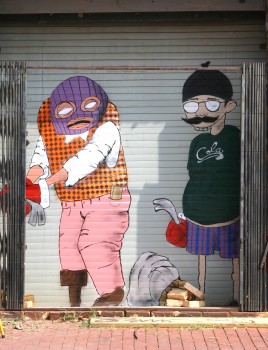
These grants represent a cultural shift in the last several years that is connected to revitalizing cities and areas that had previously been stigmatized for being crime ridden and not community minded. Cities such as D.C. are starting to see graffiti and street art less as a blight that causes, as DC.gov claims, “increased criminal activity in the surrounding neighborhoods.”
“Some people hate on graffiti because they think we are destroying a place,” Towles says, “but I don’t see it that way. Look at advertisements—those people think they can just advertise whatever they want to society and think that people’s opinions don’t count. You know, other people show them. People share their own messages.”
“Graffiti is the freest form of expression that there is,” he tells me.
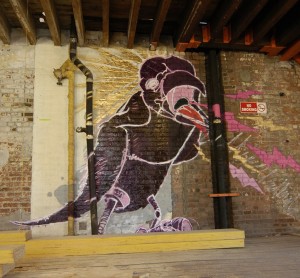
The wonderful reality of street art is exactly that—it’s free. No museum entrance fee, no gallery price tag. Also, if you are so inclined, it’s free for the taking. I recently met a staff member from a U.S. Senator’s office who was enamored of Towles’s art. He bought one of Towles’s pieces from a gallery, and, at the time we spoke, planned to “steal” a piece he saw painted on wood and displayed on an alley wall. He hadn’t taken it then because he didn’t have any tools to unscrew the artwork.
“He couldn’t get it off?” Kelly asks, smiling. “Honestly, when street art goes anywhere, it is public domain. If I go out and put a piece up, I try to go out and get a picture of it at the time or the next morning, if it’s still there. Nine times out of ten it’s either stolen or vandalized, and I don’t get bitter about that stuff. That’s what it’s there for. It’s there to make people intrigued or smile, or if they feel the compulsion to steal, I think I’ve raised something out of them to be that adamant about my art, which is kind of rad but at the same time kind of sucks because you want it to be there for a long time.”
D.C. puts hundreds of thousands of dollars a year into removing graffiti—they spent $800,000 on cleaning graffiti from walls and buildings in 2007 alone. You can now even order your own free “Graffiti Removal Kit” from the D.C. Department of Public Works (DPW). However, slowly realizing that a monochromatic square of painted-over graffiti does little to revive a community, D.C. is now devoting more funds to public art, such as that by Towles.
Towles is just one of many artists fortunate to receive funding to beautify the city. Recently, D.C. Council member Jim Graham started a $100,000 project called MuralsDC, a program that will select graffiti-targeted buildings and spaces as places for murals. According to The Washington Post, “The underlying belief in the program was that by incorporating the graffiti artists in the creation of the murals, young people would be reluctant to participate in illegal tagging.”
How does one become a paid street artist? Towles was nominated anonymously for his first grant, and his second grant came from his desire to improve his community. The application process for the grant was an “extremely long and detailed one,” Towles writes in a comment to a Prince of Petworth blog post. Not only did he seek approval from ANC, among other D.C. departments, but also he made sure to involve the community and neighbors. He handed out information explaining his project six months before he began, allowing people sufficient time to contact him with any questions concerning the mural.
However, despite his current position as professional artist and D.C. muralist, Towles started his artistic career at a grocery store.
“I started working at Whole Foods when it was Fresh Fields, just working in produce,” he says. “I would always do the chalkboards, you know—this was right after high school.”
While working at the grocery store, he decided to earn a degree in fine arts from the University of Maryland. When I ask him what he learned from his BFA, Towles says that his most important lesson came from his professor, artist Foon Sham.
“Anyone who asks me that question gets the same answer,” Towles says. “How to kick my art and have it not fall apart.”
Towles means this literally.
“One time I had a sculpture,” he says, “and it was kind of wobbly or whatever, and we were critiquing it, and he [Foon Sham] just kicks it. I was like, ‘What the hell?’ He says, ‘Well, it didn’t fall apart.’ I think, ‘Good point,’ and he says, ‘Then it’s well made.’”
Towles pauses and smiles. “But then a piece of it fell off, and he says: ‘Hmm. Not so well made.’”
Now Towles applies this principle to everything is he does. He says, “I really try not to put something out if it won’t stand kicking.”
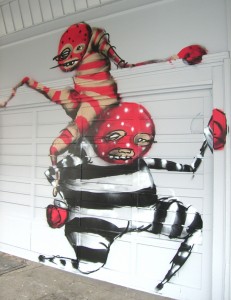
So far, his art has stood the test. Not only does his work catch the attention of D.C. passersby, his art can also be seen in many galleries throughout the United States. Recently, Towles was chosen to appear along with several other contemporary artists in Los Angeles in the Manifest Equality exhibit to promote LGBT civil rights.
His body of work extends across a huge scope — from paintings to large murals to installations. His paintings are housed in various galleries throughout D.C., and he has shown work in other major cities, including Los Angeles and New York. He also has designed artwork for Dashboard Confessionals, Jakob Dylan, The Buzzcocks, and other musical groups.
In addition to walls, galleries, and security grates, this past winter he discovered a new hobby: snow graffiti. When D.C. experienced its roughest winter in years, affectionately called “Snowmagedon” by the Washington Post, Towles decided to put the new white canvas to use. He spray-painted snowmen around the neighborhoods of D.C. with Jeff Jetton, a writer and contributor to the D.C. arts and music blog Brightest Young Things. When I later contacted Jetton and asked about the legality of “snowiffiti,” Jetton explained that they weren’t doing anything wrong.
“Kelly kept looking around nervously and a few times we ran when cops came,” Jetton says, “but I doubt there’s any legislation on painting on snow. It doesn’t belong to anybody so it’s not like you’re destroying anyone’s property.”
At one point, Towles found himself accidentally spray-painting a child’s snowman, much to a parent’s dismay, who yelled at him from her window.
“I thought it was my friend’s,” Towles explains to me, a bit sheepishly.
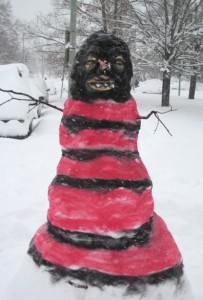
But for Towles, “anything is fair game.” Cars, walls, security grates, and snowmen. In February, Towles even spray-painted a snowman in front of the Hotel Palomar doorman in Dupont Circle.
“We just asked the Valet guys if we could paint the snowman and they laughed and said it was all ours,” Jetton says. “The doormen kept coming out to check on the progress and bringing other employees to see the work. They got a major kick out of it.”
Towles has made a lasting impression on Washington. His many murals, including the Grate Project pieces as well as the mural Scout funded by the DC Commission for the Arts, which can be found on W Street between 11th and 12th N.W., have received very positive attention from the community. The W Street mural received comments on DC blogs such as: “I love it—I can see this from my roof,” “Amazing,” and “I don’t know quite what I’m looking at, but I like it.”
Grants such as the ones received by Towles and the DPW’s MuralsDC project, which is now in its third year, are more vital than ever to help remind people that art is a necessity, not a luxury. With numerous galleries moving or shutting down due to the economic recession, artists are unemployed at twice the rate of other professionals, according to the National Endowment for the Arts.
Murals such as Scout help bring life into communities by brightening the atmosphere. In a response to murals in general, one blogger writes: “This is why I prefer to live in the city rather than beige, antiseptic, cookie-cutter suburbs.” Also, illegal graffiti and “tagging” have decreased as murals have gone up. DPW spokeswoman Nancee Lyons says government-sponsored murals have succeeded in deterring graffiti at the same sites.
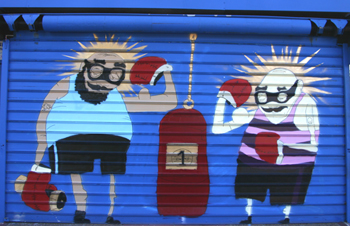
Not everyone needs to analyze the social value of art to appreciate it, however.
“I’m not someone who gets too deep about an artist’s perspective or mantra or why they do what they do,” Jetton says. “I just know what I like when I see it. And I’ve always thought Kelly’s stuff was a blast to look at. It always presents people or especially animals in ways that you never would have thought of before.”
“Plus,” Jetton adds, “Kelly’s about the nicest person you could possibly imagine. And that goes a long way.”
News and work by Kelly Towles may be found at his website, kellytowles.com.
Kate Sayre is a freelance writer and MFA candidate in fiction at the University of Florida. She is currently working on a collection of short stories.

0 comments on “Public Art: Towles”